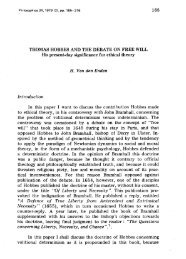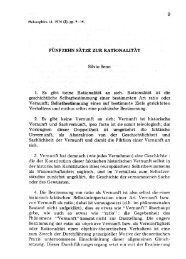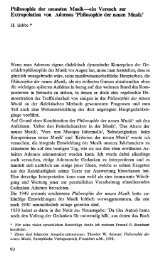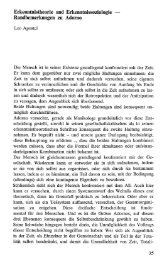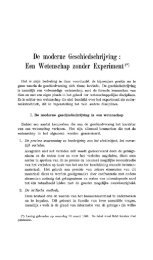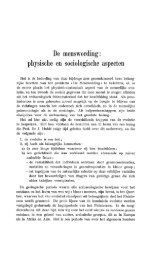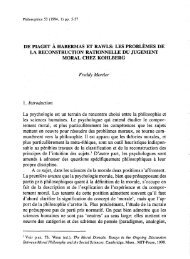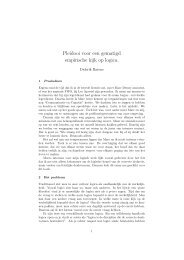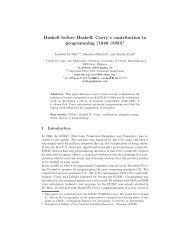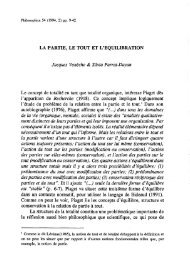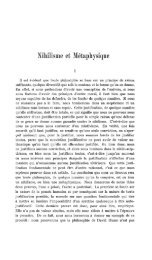CHEZ FERMAT A.D. 1637' Erkka Maula and Eero Kasanen Abstract ...
CHEZ FERMAT A.D. 1637' Erkka Maula and Eero Kasanen Abstract ...
CHEZ FERMAT A.D. 1637' Erkka Maula and Eero Kasanen Abstract ...
You also want an ePaper? Increase the reach of your titles
YUMPU automatically turns print PDFs into web optimized ePapers that Google loves.
130 ERKKA MAULA & EERO KASANEN<br />
For geometrical figures are concrete <strong>and</strong> constitute the<br />
primary objects of underst<strong>and</strong>ing for Fermat's Greek predecessors.<br />
Higher potencies are abstract (the Greeks favoured<br />
squares <strong>and</strong> cubes), unless made concrete by means of geometrical<br />
constructions.<br />
That again is what we have learned to expect in Greek<br />
contexts: a surprising concreteness, as it were, amidst the most<br />
abstract thought, such as the gnomon about which a whole<br />
world-view is turning [17], or a combination of sliding calipers<br />
<strong>and</strong> a plane sun-dial in the hub of Eudoxus's astronomy [11]. It<br />
is compatible with early Greek ideas of aIl scientific demonstration<br />
[cf. 16] <strong>and</strong>, we submit, also with Fermat.<br />
In particular, geometric proof <strong>and</strong> intuition were legitime<br />
tools for Fermat just as they had been for the Greeks. That is<br />
why we direct our search for Fermat's heuristies ta geometry.<br />
FLT, however, has implications whieh reach other fields of<br />
mathematies <strong>and</strong> physics as well.<br />
The antecedents of FLT eonsist of three propositions <strong>and</strong><br />
lemmas.<br />
Prap. 1. If p(x,n) + p(y,n) = p(z,n) has a solution in positive<br />
integers <strong>and</strong> n > 2, then (x,y,z) are sides of a sealene<br />
triangle (0 < x < y < z).<br />
If z =:; x or z :s y, then p(z,n) < p(x,n) + p(y,n). Hence z > x <strong>and</strong> z<br />
> y. If z > x + y, then p(z,n) > p(x+y,n) > p(x,n) + p(y,n). Henee<br />
z < x + y. But if further x = y, then p(z,n) = 2p(x,n) = 2p(y,n)<br />
<strong>and</strong> z = r(2,n)x = r(2,n)y where x, y <strong>and</strong> z cannot aIl be integers.<br />
Hence x t y. Let x < y. Thus z > y > x. From this <strong>and</strong> from z < x<br />
+ y it follows that y < z + x, x < z + y, z - y < x, y - x < z <strong>and</strong> z<br />
- x < y. Therefore (x,y,z) are integer sides of a scalene triangle<br />
by Euelid's Elements I.20.QED<br />
In what follows we subdivide positive-side scaIene triangles,<br />
say (a,b,c); a > b > c > 0, into aeute-angled, right-angled <strong>and</strong><br />
obtuse-angled sealene triangles (with positive sides) <strong>and</strong> define<br />
the equivalenees:<br />
Def. 1. A scalene triangle (a,b,e) is aeute-angled iff p(a,2) <<br />
p(b,2) + p(c,2); a > b > e.<br />
Def. 2. A scalene triangle (a,b,e) is right-angled iff p(a,2) =<br />
p(b,2) + p(c,2); a > b > e.<br />
Def. 3. A scalene triangle (a,b,e) is obtuse-angled iff p(a,2)<br />
> p(b,2) + p(e,2); a > b > e.<br />
As a matter of faet, Euelid's Elements distinguishes (I:Defs.<br />
10,11,12) acute, right <strong>and</strong> obtuse angles [17:173]; for Defs. 1-3<br />
see Heron's MetricB l, chA. In Euclid, the right angle <strong>and</strong> its<br />
simple parts suffice [17:173-7].



